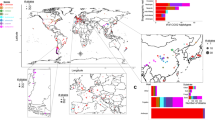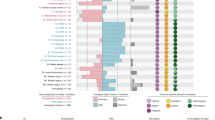Abstract
Since the completion of the genome sequence of Saccharomyces cerevisiae in 1996 (refs 1, 2), there has been a large increase in complete genome sequences, accompanied by great advances in our understanding of genome evolution. Although little is known about the natural and life histories of yeasts in the wild, there are an increasing number of studies looking at ecological and geographic distributions3,4, population structure5,6,7,8 and sexual versus asexual reproduction9,10. Less well understood at the whole genome level are the evolutionary processes acting within populations and species that lead to adaptation to different environments, phenotypic differences and reproductive isolation. Here we present one- to fourfold or more coverage of the genome sequences of over seventy isolates of the baker’s yeast S. cerevisiae and its closest relative, Saccharomyces paradoxus. We examine variation in gene content, single nucleotide polymorphisms, nucleotide insertions and deletions, copy numbers and transposable elements. We find that phenotypic variation broadly correlates with global genome-wide phylogenetic relationships. S. paradoxus populations are well delineated along geographic boundaries, whereas the variation among worldwide S. cerevisiae isolates shows less differentiation and is comparable to a single S. paradoxus population. Rather than one or two domestication events leading to the extant baker’s yeasts, the population structure of S. cerevisiae consists of a few well-defined, geographically isolated lineages and many different mosaics of these lineages, supporting the idea that human influence provided the opportunity for cross-breeding and production of new combinations of pre-existing variations.
This is a preview of subscription content, access via your institution
Access options
Subscribe to this journal
Receive 51 print issues and online access
$199.00 per year
only $3.90 per issue
Buy this article
- Purchase on Springer Link
- Instant access to full article PDF
Prices may be subject to local taxes which are calculated during checkout




Similar content being viewed by others
Accession codes
Primary accessions
GenBank/EMBL/DDBJ
Data deposits
ABI data were submitted to the NCBI Trace Archive (accession numbers: TI1250539685 –TI1250559725, TI1253231395–TI1253251114, TI1253289161–TI1253346699, TI1253412335–TI1253476299, TI1253519268–TI1253585710, TI1253601045–TI1253652620, TI1253786059 –TI1253860555, TI1253882296–TI1253926729, TI1253930843–TI1253993129, TI1253998006–TI1254046664, TI1254080659 –TI1254150525, TI1254155855 –TI1254203444, TI1254229054 –TI1254316243, TI1254369656 –TI1254427407, TI1254441246 –TI1254496019, TI1254545851 –TI1254582436. The Solexa data were submitted to the European Read Archive (accession number ERA000011).
References
Goffeau, A. et al. Life with 6000 genes. Science 274, 546–567 (1996)
Mewes, H. W. et al. Overview of the yeast genome. Nature 387 (suppl.). 7–8 (1997)
Sampaio, J. P. & Goncalves, P. Natural populations of Saccharomyces kudriavzevii in Portugal are associated with oak bark and are sympatric with S. cerevisiae and S. paradoxus. Appl. Environ. Microbiol. 74, 2144–2152 (2008)
Sniegowski, P. D., Dombrowski, P. G. & Fingerman, E. Saccharomyces cerevisiae and Saccharomyces paradoxus coexist in a natural woodland site in North America and display different levels of reproductive isolation from European conspecifics. FEMS Yeast Res. 1, 299–306 (2002)
Aa, E., Townsend, J. P., Adams, R. I., Nielsen, K. M. & Taylor, J. W. Population structure and gene evolution in Saccharomyces cerevisiae. FEMS Yeast Res. 6, 702–715 (2006)
Koufopanou, V., Hughes, J., Bell, G. & Burt, A. The spatial scale of genetic differentiation in a model organism: the wild yeast Saccharomyces paradoxus. Phil. Trans. R. Soc. Lond. B 361, 1941–1946 (2006)
Kuehne, H. A., Murphy, H. A., Francis, C. A. & Sniegowski, P. D. Allopatric divergence, secondary contact, and genetic isolation in wild yeast populations. Curr. Biol. 17, 407–411 (2007)
Liti, G., Barton, D. B. & Louis, E. J. Sequence diversity, reproductive isolation and species concepts in Saccharomyces. Genetics 174, 839–850 (2006)
Ruderfer, D. M., Pratt, S. C., Seidel, H. S. & Kruglyak, L. Population genomic analysis of outcrossing and recombination in yeast. Nature Genet. 38, 1077–1081 (2006)
Tsai, I. J., Bensasson, D., Burt, A. & Koufopanou, V. Population genomics of the wild yeast Saccharomyces paradoxus: Quantifying the life cycle. Proc. Natl Acad. Sci. USA 105, 4957–4962 (2008)
Pretorius, I. S. Tailoring wine yeast for the new millennium: novel approaches to the ancient art of winemaking. Yeast 16, 675–729 (2000)
Fay, J. C. & Benavides, J. A. Evidence for domesticated and wild populations of Saccharomyces cerevisiae. PLoS Genet. 1, 66–71 (2005)
Liti, G., Peruffo, A., James, S. A., Roberts, I. N. & Louis, E. J. Inferences of evolutionary relationships from a population survey of LTR-retrotransposons and telomeric-associated sequences in the Saccharomyces sensu stricto complex. Yeast 22, 177–192 (2005)
Naumov, G. I., James, S. A., Naumova, E. S., Louis, E. J. & Roberts, I. N. Three new species in the Saccharomyces sensu stricto complex: Saccharomyces cariocanus, Saccharomyces kudriavzevii and Saccharomyces mikatae. Int. J. Syst. Evol. Microbiol. 50, 1931–1942 (2000)
Carter, D. M. Saccharomyces genome resequencing project. Wellcome Trust Sanger Institute 〈http://www.sanger.ac.uk/Teams/Team118/sgrp/〉 (2005)
Kellis, M., Patterson, N., Endrizzi, M., Birren, B. & Lander, E. S. Sequencing and comparison of yeast species to identify genes and regulatory elements. Nature 423, 241–254 (2003)
Pritchard, J. K., Stephens, M. & Donnelly, P. Inference of population structure using multilocus genotype data. Genetics 155, 945–959 (2000)
Wei, W. et al. Genome sequencing and comparative analysis of Saccharomyces cerevisiae strain YJM789. Proc. Natl Acad. Sci. USA 104, 12825–12830 (2007)
Schacherer, J., Shapiro, J. A., Ruderfer, D. M. & Kruglyak, L. Comprehensive polymorphism survey elucidates population structure of Saccharomyces cerevisiae. Nature 10.1038/nature07670 (this issue)
Tajima, F. Statistical method for testing the neutral mutation hypothesis by DNA polymorphism. Genetics 123, 585–595 (1989)
McDonald, J. H. & Kreitman, M. Adaptive protein evolution at the Adh locus in Drosophila. Nature 351, 652–654 (1991)
Bulmer, M. The selection-mutation-drift theory of synonymous codon usage. Genetics 129, 897–907 (1991)
Clark, R. M. et al. Common sequence polymorphisms shaping genetic diversity in Arabidopsis thaliana. Science 317, 338–342 (2007)
Warringer, J. & Blomberg, A. Automated screening in environmental arrays allows analysis of quantitative phenotypic profiles in Saccharomyces cerevisiae. Yeast 20, 53–67 (2003)
Diamond, J. Evolution, consequences and future of plant and animal domestication. Nature 418, 700–707 (2002)
Legras, J. L., Merdinoglu, D., Cornuet, J. M. & Karst, F. Bread, beer and wine: Saccharomyces cerevisiae diversity reflects human history. Mol. Ecol. 16, 2091–2102 (2007)
Wiens, F. et al. Chronic intake of fermented floral nectar by wild treeshrews. Proc. Natl Acad. Sci. USA 105, 10426–10431 (2008)
Mancera, E., Bourgon, R., Brozzi, A., Huber, W. & Steinmetz, L. M. High-resolution mapping of meiotic crossovers and non-crossovers in yeast. Nature 454, 479–485 (2008)
Demogines, A., Wong, A., Aquadro, C. & Alani, E. Incompatibilities involving yeast mismatch repair genes: a role for genetic modifiers and implications for disease penetrance and variation in genomic mutation rates. PLoS Genet. 4, e1000103 (2008)
Siva, N. 1000 Genomes project. Nature Biotechnol. 26, 256 (2008)
Acknowledgements
We thank all the members of the Sanger sequencing production teams for generating the sequence data. We thank members of the Durbin and Louis laboratories and C. Nieduszynski for comments and suggestions, L. Kruglyak and J. Schacherer for sharing their unpublished manuscript and R. Ames and S. Lovell for sharing unpublished results. We also thank the British Council and Chinese Academy of Sciences for providing the opportunity to design and develop this project. Research at the Wellcome Trust Sanger Institute (D.M.C., A.M.M., L.P, M.J., M.A.Q., I.G., S.S., F.S. and R.D.) is supported by The Wellcome Trust. G.L., D.B.H.B., E.B. and E.J.L. were supported by the Wellcome Trust, the Royal Society and the Biotechnology and Biological Sciences Research Council (BBSRC). S.A.J., R.P.D. and I.N.R. were supported by the BBSRC. A.B. and J.W. were supported by the Swedish Research Council and the Swedish Foundation for Strategic Research. A.B. and V.K. were supported by the National Environment Research Council (NERC) and I.J.T. was supported by the Wellcome Trust. D.B. was supported by NERC. A.M.M. was supported by the Canada Foundation for Innovation. M.J.T.O. and A.v.O. were supported by the National Science Foundation, the National Institutes of Health and a Hertz fellowship.
Author Contributions R.D. and E.J.L. designed the project. G.L. selected and manipulated yeast strains and extracted DNA samples. M.J., M.A.Q., I.G., S.S. and F.S. performed the subcloning and sequencing. D.M.C. did the reference comparison and assembly of the sequences. D.M.C. and G.L. coordinated the collection of data. D.M.C. and R.D. performed much of the global analysis, which was the basis for specific analyses performed by the other authors. A.M.M. did the selection studies. E.J.L., G.L., D.M.C. R.D., D.B.H.B., E.B. and L.P. did the population structure and analysis of new genes. C.M.B. and D.B. performed the analysis of Ty-element abundance. S.A.J., R.P.D., M.J.T.O., A.v.O. and I.N.R. analysed the rDNA. A.B., V.K. and I.J.T. did the sequence variation and recombination analyses. A.M.M. and A.N.N.B. created a BLAST server. J.W. and A.B. generated the phenomics data. E.J.L. and G.L. wrote the paper, coordinating the contributions of the other authors.
Author information
Authors and Affiliations
Corresponding authors
Supplementary information
Supplementary Information
This file contains Supplementary Methods, Supplementary Tables S1-S7, Supplementary Data and Supplementary References (PDF 872 kb)
Supplementary Figures
This file contains Supplementary Figures S1-S10 with Legends (PDF 1538 kb)
Rights and permissions
About this article
Cite this article
Liti, G., Carter, D., Moses, A. et al. Population genomics of domestic and wild yeasts. Nature 458, 337–341 (2009). https://doi.org/10.1038/nature07743
Received:
Accepted:
Published:
Issue Date:
DOI: https://doi.org/10.1038/nature07743
This article is cited by
-
The fitness trade-off between growth and stress resistance determines the phenotypic landscape
BMC Biology (2024)
-
From beer to breadboards: yeast as a force for biological innovation
Genome Biology (2024)
-
Ancient and recent origins of shared polymorphisms in yeast
Nature Ecology & Evolution (2024)
-
Single nucleotide polymorphisms associated with wine fermentation and adaptation to nitrogen limitation in wild and domesticated yeast strains
Biological Research (2023)
-
Detecting natural selection in trait-trait coevolution
BMC Ecology and Evolution (2023)
Comments
By submitting a comment you agree to abide by our Terms and Community Guidelines. If you find something abusive or that does not comply with our terms or guidelines please flag it as inappropriate.



